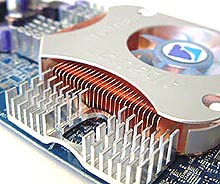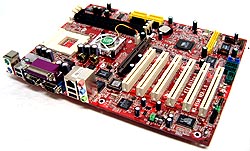|
The State of Graphics GPU's
Hello,
I'm just going
to jump right
in this week and let you know about our review of a GF4 Ti4200P-Turbo
video card which is built on a Ti4600 PCB with 3.3ns BGA DRAM. If that Albatron
GeForce Ti4200 isn't enough to spark your interest, then perhaps I can tempt you
with a VIA KT400 based motherboard sporting Serial ATA and 10/1000 LAN! What, still not
enough?
Okay - Corsair have recently gained a lot of
attention with their PC3200 DDR400 memory, and Colin's review breaks
out the real deal.
Now if fast memory, fast video cards and fast motherboards aren't your thing, then maybe
you'll be interested in our review of a 19" LCD from Hitachi. This
sleek black display impressed us
, so
it might just impress you to.
With the number of aluminum cases on
the market it was only a matter of time before an all-black,
all-aluminum power supply showed up. The VA-470W from Vantec certainly
caught our attention, but if you want something which is really silent
then you'll have to look at this 300W quiet power supply from Zalman. Colin even
gets into some foam for "case quieting reasons' this week so be sure to
check out Colin's Weekly Tech Tips! Until next week...
 With so much competition, manufacturers are finding
it increasingly difficult to differentiate themselves from their
rivals. Albatron is trying to lure customers by running a GeForce4 Ti4200
faster than their competition and this increase can potentially
place the Ti4200P-Turbo
at Ti4600 levels. So what's so unique about the Albatron GeForce4
Ti4200P Turbo itself?
With so much competition, manufacturers are finding
it increasingly difficult to differentiate themselves from their
rivals. Albatron is trying to lure customers by running a GeForce4 Ti4200
faster than their competition and this increase can potentially
place the Ti4200P-Turbo
at Ti4600 levels. So what's so unique about the Albatron GeForce4
Ti4200P Turbo itself?
To start things off, the Albatron GF4 Ti4200P
Turbo uses the same 8-layer PCB design
as GeForce4 Ti4400/Ti4600 videocards. It has a very impressive and well designed GPU heatsink (which
we'll get into later), some flashy memory sinks, TV-Output (using the
Phillips 7104E) and finally a DVI output. The Albatron GeForce4 Ti4200P-Turbo uses an 8-layer PCB
which is more expensive to produce and it also uses higher quality 3.3ns BGA DDR
RAM of which there is 128MB in this version.
Article Link: Click here to read
| price comparisons:
looking for an 8x agp video card? check out the links to the left. |
Shop for Video Cards
ATI, Asus, PNY, MSI, Albatron, etc. |
Motherboards
Abit, ASUS, iWill, Shuttle, Soyo, and More... |
Processors
AMD / Intel
Memory
RDRAM, DDRAM, SDRAM |
 It's nice to see that MSI continually upgrade their boards
to the latest technological goodness. This time however, it is the two
little black sockets on the MSI KT4 Ultra-FISR which are
revolutionary, and actually really exciting... for a techie anyway
:)
It's nice to see that MSI continually upgrade their boards
to the latest technological goodness. This time however, it is the two
little black sockets on the MSI KT4 Ultra-FISR which are
revolutionary, and actually really exciting... for a techie anyway
:)
Before we get into that, you should know that
the KT4 Ultra-FISR is based on the brand new the VIA KT400 chipset. The
KT400 chipset supports
AthlonXP processors at FSB's of 100MHz, 133MHz, and the tantalizing
166MHz. Now even with on board IEEE1394 and bluetooth support, it is
really those two small
Serial ATA 150 connectors
which manage to draw our undivided attention. Serial
ATA is the new spec for connecting devices like hard drives, and
as you will see, Serial ATA cables are really tiny and operate on a
point-to-point topology. Looking around the cramped PCB on the MSI KT4
Ultra-FISR, we can say it's easily the most equipped motherboard we've
ever tested!
Article Link: Click here to read
When one wants premium quality memory, there are
only a few names that come to mind first; Mushkin, Crucial and Corsair.
Today we're going to be reviewing a 256MB stick
of Corsair XMS3200 CAS2 DDR400
to see if it is as good as
everyone says it is. So why do overclockers & enthusiasts hold Corsair
in such high regard? Well, Corsair has been around since 1994
and they've been producing and delivering some of the best
overclocking memory from our experience. They released their XMS2400 right after
JEDEC approved the PC2100 standard! Each new Corsair
memory design (say PC2700, or PC3200 in
this case) is thermally shock tested with loving care and then assembled
with in house tools and QA controls to be a faster, stronger,
hopefully better
stick of overclocking
memory.
Article Link: Click here to read

I'm always a little undecided when it comes
to choosing between a 19" TFT
display and an 18.1" one. The reason is that both displays, while they
do differ in screen size by about an inch, have the same fundamental
native resolutions. The 19" display's
we've tested have all had resolutions of 1280x1024 as do the the 18.1"
TFT displays. The true difference lies in price and pixel pitch. A 19"
display will cost a little more and the pixel pitch is going to be on the
order of 0.294mm. Conversely, an 18.1" display will have a slightly
tighter pixel pitch of 0.280mm or 0.281mm depending on how exact the
manufacturer is in their measurements, and cost a little less for
something quite comparable.
Article Link: Click here to read
|
Vantec 470W Stealth Powersupply
Review |
|
Zalman 300W ZM300A-APF Quiet
Power Supply |
|
It's pretty rare these days to look at a
powersupply and
be impressed with its
appearance. Now granted, what's on the
inside of a powersupply is ten times as
important has how the equipment looks, but with case modding and
highly detailed systems out there it seems like a shame to install
just another well made,grey ,
powersupply. As consumers, we should have the option of going for
something with the power, and class, to make a full aluminum case -
all aluminum! The PFC VAN-470 comes with a 24-pin to 20-pin
ATX power adaptor so the powersupply easily plugs
into standard desktop boards. In addition to the standard computer power
plug we find a standard switched AC power socket. Article Link:Click here to read |
|
When was the last time you gave more
than a passing thought to your power supply? If it works, good. If
it can supply 300 Watts, super. If it
makes noise.... you live with it right? The answer to that last
question doesn't always have to be no, and in the case of the Zalman ZM300A-APF
the answer most certainly is "quiet."
So as we opened up the
box for the ZM300A-APF
a low noise power supply greeted us. Zalman's power supply comes with one
internal exhaust fan, (7) molex connectors, (2) FDD connectors, a
24-pin ATX connector, and a 6-pin & 4-pin Pentium 4 auxiliary
power connector.
Article Link: Click
here to read |
Colin's Weekly Tech Tips
By: Colin "let's try Liquid Nitrogen" Sun |

Beginners Soundproofing for Computers
With
computers producing more heat then ever before people are
equipping their computers with bigger heatsinks, and more powerful
fans. The big negative effect is the increase in noise that comes
with this extra cooling. I've made a decision to change my ways,
and so gone are the days of using a 7000RPM Delta fan which
screams like a vacuum. I just can't stand the noise anymore. When
I recently moved my system from AMD to P4, I was amazed at how
quiet my computer had become but I was still not satisfied. I was
determined to quiet it down even more!
There are plenty of sound absorbing products on the market like this and this, but what I wanted to try a trick and keep things cheap. What I did to try and "quiet" down my computer was tape some antistatic Polyester foam to the inside panels of my case. Polyester (this black foam comes in most retail motherboard packages for cushioning). While Polyester foam isn't the most technically engineered sound absorbing material, it's readily available at your local computer retailer and will most likely be free!
After doing this quick little trick I
found that my computer was a few decibels quieter and some
occasional rattling from the side panels (I have an 3 year old
Lian Li PC-70 Aluminum case) had stopped! My computer is a little
bit quieter, and I think we can all agree that is a good thing. If
you think your computer noise is unbearable this little mod might
be worth a try.
Colin's Tech Tips have been archived
for your reading
enjoyment! |
Hey did you see that thread in the PCStats Forums
today? Sign up, join in, and get the discussions going!
|
|
PCstats
Issue No.58
Circulation 149,000
The High Tech Low
Down
With Chris
Angelini |
|
Last week, I had the opportunity to sit down with one of the larger graphics manufacturers and talk about upcoming products. This particular manufacturer is readying a follow-up to an already-successful 3D processor - don't worry, I'll have more information on the product itself next week. For now, I'd like to focus on graphics technology itself.
ATI's R300, with its eight pixel pipelines, sports more than 107 million transistors. The upcoming NV30 is rumored to be comprised of over 120 million. Note that both processors feature roughly twice the transistor count of Intel's Pentium 4. Naysayers (who were later proved incorrect) taunted ATI, claiming it couldn't hit 320MHz using a .15-micron process to manufacture the R300. Keeping in mind that NVIDIA will use a smaller, .13-micron process, I'd expect at least similar clock frequencies from NV30.
Now, we've established that the hardware necessary to play next-generation games is quickly falling into place. What we need now are DirectX 9 games to unleash the power of these programmable processors. Don't hold your breath though - it takes a few years to write a top-notch game. At least we can look forward to decent DirectX 8 games by Christmas, right?
|
|
Next Week |
|
More tips, and tweaks from the Colin, and lots
more hardware!!

|
Media and Advertising Enquiries.
|
